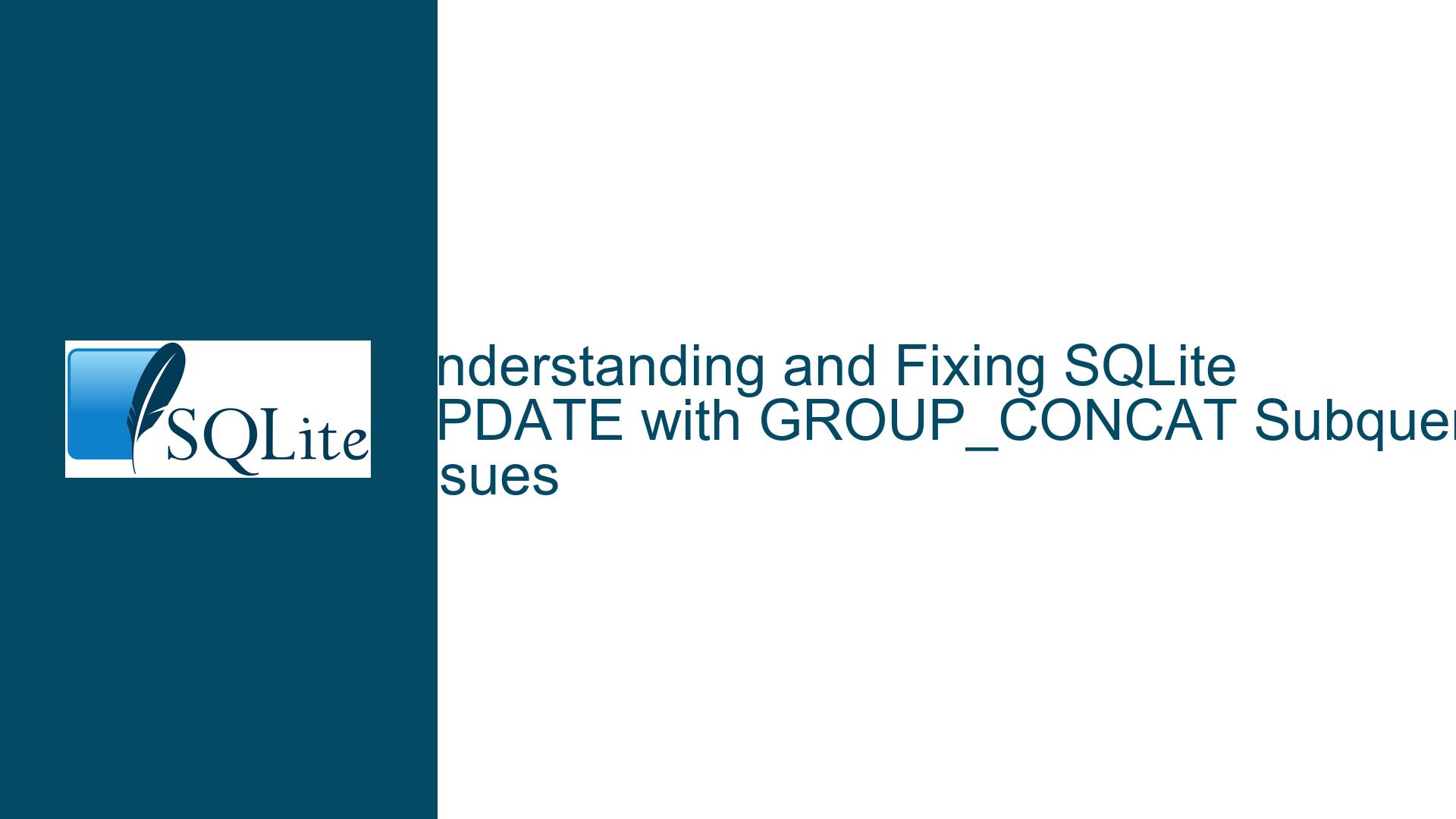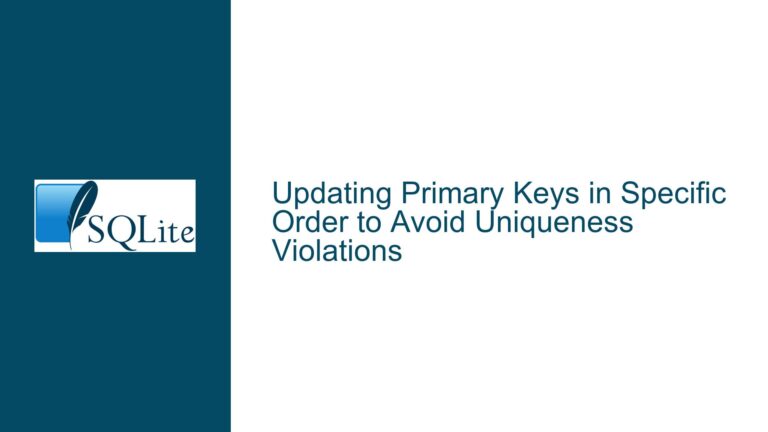and Fixing SQLite UPDATE with GROUP_CONCAT Subquery Issues
Incorrect Row Updates Due to Uncorrelated GROUP_CONCAT Subquery
When working with SQLite, a common task is to update a column in a table based on aggregated data from the same table. One such aggregation function is GROUP_CONCAT, which concatenates values from multiple rows into a single string. However, when using GROUP_CONCAT in a subquery within an UPDATE statement, unexpected behavior can occur if the subquery is not properly correlated with the rows being updated.
In the provided scenario, the user attempted to update the Plaasnommers column in the wingrd13 table by setting its value to the result of a GROUP_CONCAT subquery. The initial query looked like this:
UPDATE wingrd13
SET Plaasnommers = (
SELECT GROUP_CONCAT(Plaasno)
FROM wingrd13
GROUP BY Aliasnaam
);
This query updates all rows in the wingrd13 table with the same concatenated string, which is the result of the GROUP_CONCAT operation for the first group of Aliasnaam. This happens because the subquery is not correlated with the outer UPDATE statement, meaning it does not distinguish between different rows in the wingrd13 table. As a result, the subquery returns multiple rows, and SQLite, unlike some other databases, does not raise an error but instead uses the first row returned by the subquery.
Uncorrelated Subqueries and Their Impact on UPDATE Statements
The core issue lies in the lack of correlation between the subquery and the rows being updated. In SQL, a correlated subquery is one that references columns from the outer query, allowing the subquery to be evaluated for each row processed by the outer query. Without this correlation, the subquery is executed independently, and its results are not tied to the specific row being updated.
In the initial query, the subquery:
SELECT GROUP_CONCAT(Plaasno)
FROM wingrd13
GROUP BY Aliasnaam
is uncorrelated. It aggregates all Plaasno values for each Aliasnaam group but does not reference the outer query’s row. Consequently, the subquery returns a single result set with multiple rows, one for each Aliasnaam group. When used in the UPDATE statement, SQLite applies the first row of this result set to all rows in the wingrd13 table, leading to incorrect updates.
Another factor contributing to the issue is SQLite’s handling of subqueries that return multiple rows. In databases like PostgreSQL, a subquery returning multiple rows in an UPDATE statement would raise an error. However, SQLite allows this and silently uses the first row returned by the subquery. This behavior can be misleading, as it does not provide an explicit warning or error when the subquery is not properly correlated.
Implementing Correlated Subqueries and Future SQLite Enhancements
To resolve the issue, the subquery must be correlated with the outer UPDATE statement. This ensures that the GROUP_CONCAT operation is performed for each row being updated, based on the corresponding Aliasnaam. The corrected query looks like this:
UPDATE wingrd13
SET Plaasnommers = (
SELECT GROUP_CONCAT(Plaasno)
FROM wingrd13 AS foo
WHERE foo.Aliasnaam = wingrd13.Aliasnaam
);
In this query, the subquery references wingrd13.Aliasnaam, which ties the subquery to the specific row being updated. For each row in the wingrd13 table, the subquery concatenates the Plaasno values for rows with the same Aliasnaam. This ensures that the Plaasnommers column is updated correctly for each row.
Additionally, future versions of SQLite will introduce enhancements that simplify such queries. For example, the following syntax will be supported:
UPDATE wingrd13
SET Plaasnommers = group_concat(S.Plaasno)
FROM wingrd13 AS S
WHERE S.Aliasnaam = wingrd13.Aliasnaam;
This syntax eliminates the need for a nested subquery by allowing the FROM clause to be used directly in the UPDATE statement. It also automatically creates a covering index if one does not exist, improving performance.
Another efficient approach involves materializing the subquery results and then performing the update:
UPDATE wingrd13
SET Plaasnommers = gcPlaasno
FROM (
SELECT Aliasnaam,
group_concat(Plaasno) AS gcPlaasno
FROM wingrd13
GROUP BY Aliasnaam
) AS S
WHERE S.Aliasnaam = wingrd13.Aliasnaam;
This method materializes the subquery results into a temporary table S, which is then joined with the wingrd13 table for the update. This approach is particularly efficient when an index on Aliasnaam exists, as it reduces the computational overhead of repeatedly executing the subquery.
Key Considerations and Best Practices
When using GROUP_CONCAT in subqueries for UPDATE statements, it is crucial to ensure proper correlation between the subquery and the outer query. Failing to do so can lead to incorrect updates, as demonstrated in the initial query. Additionally, understanding SQLite’s behavior regarding subqueries that return multiple rows is essential for avoiding unexpected results.
For optimal performance, consider the following best practices:
- Correlate Subqueries: Always ensure that subqueries in
UPDATEstatements reference columns from the outer query to maintain row-specific context. - Use Indexes: Create indexes on columns used in
GROUP BYandWHEREclauses to improve query performance. - Leverage Future Enhancements: Stay informed about upcoming SQLite features, such as the ability to use
FROMclauses directly inUPDATEstatements, which can simplify queries and enhance performance. - Test Queries Thoroughly: Before applying updates to production data, test queries on a sample dataset to verify their correctness and efficiency.
By following these guidelines and understanding the nuances of SQLite’s query execution, you can effectively use GROUP_CONCAT in UPDATE statements to achieve accurate and efficient results.






